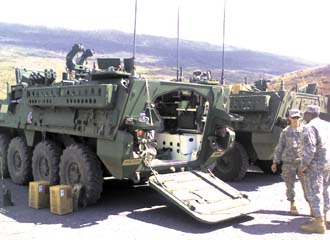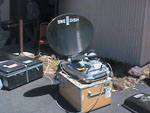Live and Virtual Assets Train Jointly
 |
The Joint Training and Experimentation Network (JTEN), a persistent global network, provides realistic joint training capability for combatant commands and services across the continental United States and abroad. The JTEN has been enhanced through the Tactical JTEN (TAC JTEN) concept, which uses a mobile communications package to extend the network to austere locations. |
An emerging virtual training solution will mitigate the challenge many small-unit joint operators face when preparing for deployment from various locations. The Tactical Joint Training and Experimentation Network addresses live-asset training gaps by extending a strategic joint training network. This network links disparate aircrews located in a simulator with live, small-unit ground forces to rehearse joint tasks.
Without the live assets or network connectivity needed to help train them as they will operate in theater, joint warfighters hit the operation ground at a disadvantage. However, the distance between these troops and high-technology training equipment often precludes adequate preparation opportunities.
Mark Williams, Tactical Joint Training and Experimentation Network (TAC JTEN) project manager and chief engineer, U.S. Joint Forces Command (JFCOM), Norfolk, Virginia, explains that his command has never been able to push this type of training down to the small units in a structured way so that the forward observer can talk directly to the attack aircraft, which is a crucial element. “This is an important improvement TAC JTEN will bring them,” he explains. The JTEN is a strategic joint training asset of JFCOM’s Joint National Training Capability (JNTC).
During a proof-of-concept event in
JFCOM, the event’s host, has developed a standards document that serves as a recipe for combatant commands (COCOMs) to build their own TAC JTEN packages. The standards document also provides them with the information they need to serve as a sub-component of the live, virtual and constructive (LVC) simulations that make up the JTEN.
The JTEN, a persistent global network, provides a realistic joint training capability for COCOMs and the services across the continental
A new tactical capability, the TAC JTEN concept was introduced in 2007 to extend the JTEN to austere locations and deliver joint context as provided by the joint training environment to small unit—platoon level and below—training. The capability concept’s objective calls for an easily transportable, lightweight mobile communications package that easily can be set up, configured, integrated and operational within two hours. The package must be able to connect remote locations with a common operational picture for joint training exercises. Using worldwide accessible commercial, military services and Defense Information Systems Agency satellite hub sites as well as the JTEN infrastructure, TAC JTEN will provide the bandwidth and connectivity necessary for collaborative communication and integration of live and virtual assets to support geographically remote, tactical joint training.
“Though no live fire occurs during a virtual exercise, the array of new communication capabilities offered by the TAC JTEN solution, as well as those that surely will follow in the future, will play a vital training role in preparing small-unit warfighters for the real thing,” Williams says.
The JFCOM Joint Training Directorate (J-7) developed the TAC JTEN as a way to extend the core JTEN via satellite communications to disparate locations throughout the world. Last year, U.S. Pacific Command (PACOM) collaborated with JFCOM’s JNTC Training Development Group to put the concept to a field test at the PTA.
 |
The TAC JTEN utilizes three mobile kits that already are used in the field. Within two hours, the kits can be set up, configured and operational, connecting remote locations with a common operational picture for joint training exercises. |
The TAC JTEN concept succeeded on a broad range of fronts. “We successfully established a node on the PTA in the 2/25th Stryker Brigade Combat Team’s 1-14th [1st Battalion/14th Infantry]
The testing event validated the TAC JTEN’s ability to extend the joint training environment and provide joint context to an austere location and home station, enhancing small-unit training capabilities. “This solution delivered LVC joint training capability to infantry squads from the 1-14th Infantry Battalion at home station in preparation for an upcoming deployment,” Williams relates. Further highlighting the significance, this training solution allows for live training that otherwise would not be possible during pre-deployment training because of the limited availability of live training assets, he adds.
The TAC JTEN links live units with virtual aircraft, including simulations of AC-130 Specter gunships, which are used during the execution phase of pre-deployment training as live assets because actual aircraft are not readily available for this work. In the proof-of-concept event, forward observers were able to conduct live training by communicating directly to an attack aircraft to conduct a time-sensitive targeting opportunity. Key to the success of this initiative is the ability to provide a mobile communication infrastructure to extend JTEN to disparate locations worldwide.
Training tactical joint maneuvers with actual radios is considered the ideal educational method, but it is not always possible because of the lack of equipment availability to the training community during wartime. To address this issue, the TAC JTEN proof-of-concept event leveraged a number of JFCOM joint training assets, including the Naval Air Systems Command and
The VTB integrated live and virtual radio communications, establishing voice communications between the forward observer, a virtual AC-130 gunship and a Predator UAV over the JTEN. The JVTR, an integrated suite of applications that realistically simulates tactical radio systems and management, provides seamless interoperability between live and simulated radios. It also provides fully interactive AN/PRC-119 manpack radio simulations. The connection is so seamless that often the trainees are unaware of what is real and what is simulated, Williams shares.
Operators participating in the TAC JTEN-supported training exercise were highly enthusiastic about the training capability because it met their requirements, Williams relates. “They also were excited that they received additional options in the original scenario that allowed them more interaction with the aircrew and variable mission threads so they could branch off. They didn’t just meet the standard and punch out ... they stayed to train,” he states.
The operators were impressed by the stark realism of the training. “At the end of training on one of the days, the forward observers wanted to swing by the tactical operations center to meet the engagement controller of the AC-130, not realizing that the aircraft was being flown virtually over the PTA from Eglin Air Force Base some 9,000 miles away.” he adds.
While those aircraft take to the air only on a virtual plain, Williams points out that a credible training scenario in a virtual exercise calls for accurate landform images. He credits the Joint Training Data Services (JTDS) for providing what he terms outstanding support. “JTDS provided us with detailed, accurate terrain data for the virtual system,” Williams says. “Constructive representations of the topography of the training area were greatly helpful in achieving the degree of realism needed for successful live, virtual training. JTDS deserves a great deal of credit for playing such a valuable role.”
The TAC JTEN proof-of-concept event demonstrated how the virtual and constructive simulation capabilities of the joint training environment can be applied to enhance and expand to live training at home stations and provide mission-critical, realistic training. For a small investment, the Joint Training Enterprise was able to validate the TAC JTEN solution in a tactical environment and demonstrate to PACOM the ability to meet mission-critical training requirements, Williams maintains.
“We were able to train forward observers from the 1-14th, which comprised 12 teams, in a live environment with multiple runs on three joint tactical tasks prior to their deployment to
Because of the nature of modern warfare, those at the squad levels are faced not only with tactical decisions but also with strategic ones, he points out. “For instance, if a school were being swarmed by insurgents, a decision has to be made as to whether to strike that structure,” Williams says. “Split-second decisions have to be made even for that squad leader in the field, who must determine whether civilians are potentially co-located with the insurgents before deciding to call in an attack.”
With such pressure placed on the small-unit operators, the ability to train with live assets helps warfighters to make those critical decisions. Williams says the small-unit-oriented joint training solution will prove to be yet another valuable tool that will give warfighters on the ground in
John S. Kostoff is the communications technical manager with the Joint Training Solutions Development Division, U.S. Joint Forces Command,
Photography by Lt. Col. Keith Perkins,
WEB RESOURCES
JFCOM Joint Training Directorate: www.jfcom.mil/about/abt_j7.htm
Joint National Training Capability: www.jfcom.mil/about/faq_jntc.htm




Comments